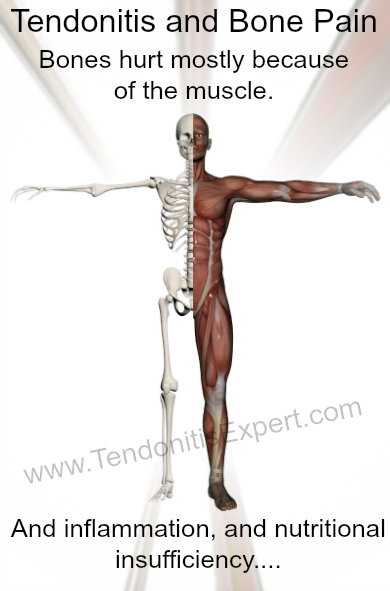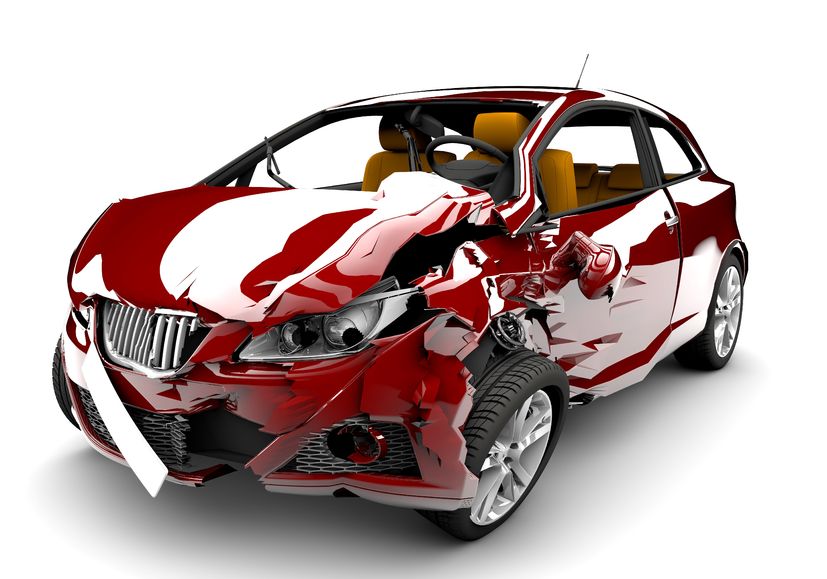Bone Pain Is A Cause of -And- A Symptom Of Tendonitis
There are many causes of Bone Pain. And that includes bone -and- joint pain.
From cancer to nutritional deficiency to impact injury from sports or car crashes, there are many possible causes of development of pain in bones.
It's important to know that the tendonitis dynamic can cause pain in bones(with or without other symptoms).
And it's important to know that bone pain can CAUSE tendonitis.
If you have pain in bones, it may be worth ruling out some of the BAD possibilities like bone cancer or bone cyst.
Bone and Joint Pain
One and the Same
Just so we're on the same page, joint pain -is- bone pain.
A joint is where two bones meet.
So when we say bone pain, we're talking about two different things:
1. Joint pain where bone meets bone, or
2. The body of the bone.
Or both.
How Does Tendonitis Cause Bone Pain?
Tendonitis is a dynamic made up of multiple factors all working together.
That's the Pain Causing Dynamic
Nutritional insufficiency, chronic inflammation, and too tight muscle and connective tissue all conspire to cause pain in a variety of ways.
- Nutritional insufficiecy can cause pain in the bones.
- Inflammation can cause pain symptoms in bones.
- Too tight muscle and connective tissue pulling on their boney connections can cause pain in a bone.
So if you have tendonitis, it's entirely possible that that dynamic can cause symptoms of boney pain.
Especially if you already have 'bad' tendonitis with pain symptoms, then the progression of those symptoms and escalation of the above three factors can naturaly evolve to add boney pain into the mix of symptoms.
There's also 'bone bending'.
How Does Bone Pain Cause Tendonitis?
Tendonitis of any kind gets aggravated by 'more pain'.
The brain registers pain, thinks that it needs to protect you from the 'danger' of more pain, and defends you by A. making muscle tighter and B. turning up the dial on the process of inflammation (which releases chemicals which makes you hurt more).
This starts a tendonitis dynamic or aggravates an existing tendonitis dynamic.
So if you get in a car crash or get kicked in the shin bone, that new pain will cause the brain to make the tendonitis dynamic worse. Or the sudden pain can (does) trigger the mechanisms that start to build a tendonitis dynamic.
Pain creates more pain and problem which creates more pain and problem.
It doesn't matter where in the body the pain is. If pain starts in a leg bone, that's where it will start causing tendonitis.
Point being, it starts locally, and spreads from there.
And, anywhere there's bone, there can be pain in that bone.
In the realm of Tendonitis, the most common 'categories' of bone pain can be found below.
But first, did you know that bones change shape?
See: What Is Tendonitis?
Pressure On Bones 'Bends' Them And Causes Pain
Bones are living tissue. If you put enough pressure on them, over time, they will bend, or reshape themselves in response to the force up them.
So if you have muscle imbalance, are stuck in bad posture, etc, that means that there is undue pressure on the bones and/or on the bone of the joints.
Give it enough time, and bones will reshape.
Give it enough pressure, and bones will hurt (because they're getting forced to bend and they don't like that).
Or they're not gettting bent, they're just getting pressed on or pulled on in any particular spot.
Painful bones and/or joints can and will result.
Bone Spur
Developing from a different set of factors (with a lot of overlap), bone spurs can cause pain.
You can also have a big spur with no pain, so the existence of one isn't sure thing for causing pain.
Bone spurs mostly develop where there is a lot of force being applied (either push or pull).
Mostly, bone spurs don't hurt (meaning, they don't cause the bone to hurt), but they can/do help cause other non-bone pain.
But if you have surgery to remove a spur that's when you're going to have a FAIR amount of pain where bone was removed forcefully from bone, resulting in pain and bone bruising.
See: Bone Spur
Bone Bruise
Somebody is playing soccer and gets kicked hard in the shin bone.
Somebody gets hit anywhere in the body with a bat or a baseball, and there's impact on or close to bone.
Car crash.
Getting kicked by a horse.
Punching a wall.
Anytime there is enough of an impact, there can be a bone bruise.
Bone bruises by default are painful and long lasting. They take longer to go away than one would expect.
And there's good reason for that.
See: Bone Bruise
Broken Rib Symptoms
Yeah...ouch.
Like fractured/broken collar bones....fractured or broken ribs HURT.
Ouchie.
See: Broken Rib Symptoms
Collar Bone Pain
Impact is the most common cause of collar bone pain.
There are primarily two causes:
- Sudden Impact Injury, like a broken of fractured bone
- Forces slowly pushing and/or pulling on it
1. Collar bone fracture or break
When I was in 8th grade the wrestling coach picked me up and slammed me to the mat. His whistle was in his shirt pocket, and the whistle hit my collar bone with some of his weight behind it.
Turns out it fractured my collar bone. (It hurt A LOT).
Now I have a boney lump on collar bone on that side. It doesn't hurt, but the lump is from new bone growth 'healing' the fracture.
2. Forces pushing/pulling on the collar bone
You know that 'hunched forward' position most people have these days from our sedentary lifestyles?
That position brings the shoulders and neck forward, so structures on the front of the neck and shoulders get shortened and stuck short.
This means muscles are constantly pulling on the collar bone that shouldn't particularly be pulling on them.
So if you feel pain in the collar bone, it may be because muscles directly attached to it are pulling on it 24/7, or it could be because the collar bone is getting literally bent as other bones it attaches too are pushing/pulling on the collar bone itself.
See: Collar Bone Pain
Foot Bone Pain
We put all our weight on our feet. Most of us put too much weight on our feet. (Take heart Americans, Australia surpassed us as the 'fattest' country in the world).
But weight really isn't the problem. The body's inability to handle the load and it's inability to recover from the stressors the body experiences is the problem.
Weight isn't the problem. Lack of functionality is the problem.
Pain in foot bones is from the Big Three of nutritional insufficiency, inflammation, and too tight muscles/conective tissue.
And joints get compressed which can cause the bones to hurt.
There are many bones and many joints in the foot. Put weight and force on that mobile arch and supporting structures, and it's easy to aggravate the pain dynamic by impact, small joint and bone bruising, constant pressure on the bones, etc.
And remember that pressure can press on and try to bend bones? What do you think is happening when you're on your feet all day?
Plantar Fasciitis is the common name for that lack of functionality. Doctors of course don't look at it like a lack of function (or they wouldn't cut the support structures that hold the arch of the foot together).
See: Plantar Fasciitis
(And really, the lower leg is a prime cause of foot pain.)
And, of course, there are broken foot bones.
See: Cuboid Fracture
Leg Bone Pain
Broken legs obviously cause pain.
Less obviously, legs that were broken in the past can hurt again many years later (remember, pain in bones adds to the Tendonitis dynamic which builds up over time).
There's a lot of working parts in the legs, from the hips where they connect to the foot bones they sit on.
So bone -and- joint pain is common in the legs.
The upper leg bones sits on the lower leg bone. Where they meet is the knee joint.
There are many many things that can go wrong here to cause bone pain.
- Different sports
- different activities
- gait problems transferring force up the leg
- being bowlegged
- childhood injuries catching up to you
- etc, etc
Knee Tendonitis is common...muscles get tight and pull on the tendon attachments. With the right conditions, this can hurt, and can be felt as bone pain.
Jaw Bone Pain
Cavities can be a cause.
Gum abcesses can be a cause.
For the purposes of this site, TMJ is a primary cause.
Temporo-Mandibular Joint Dysfunction creates many symptoms, including aching and painful jaw muscles, headaches, and jaw pain that feels like it's in the jaw bone.
See: What Is TMJ?
Osteoporosis Bone Pain
Osteoporosis rarely has any symptoms UNTIL there is a fracture or a break.
Then obviously there is pain from the fractured/broken bone.
Having said that, some back pain, neck pain, wrist pain (mostly in the very elderly) is from tiny bone fractures.
Osteoporosis is a loss of bone density from lack of nutrition. Bones shrink and become structurally weak.
And that causes pain when the weakened bones fracture and/or break.
See: Article On Osteoporosis
Sit Bone Pain
The SITS bones (ischial tuberosity) are the bones you sit on, literally/basically.
And the hamstrings attach to those bones. Tight hamstrings pull on the attachments to the bone.
That constant pulling causes pain.
And there's a lot of other muscles there in the 'butt' area. They get tight, they pull on their attachments.
And it all contributes to the Pain Causing Dynamic.
And then the bones you sit on hurt...and you sit on them! Again and again. Bones pressing into flesh pressing into some (usually) hard object like a chair.
That adds irritation to an already irritated dynamic.
Tailbone Pain
Most tailbone pain comes from landing heavily on the tailbone, when falling down or sitting down wrong or too hard.
If the bony structure gets knocked out of joint.....it's REALLY painful.
The only real fix for this is to adjust the bone back in place. The good news is, that helps a lot.
The bad news is, the adjustment can only be done internally. So when you look at the geography of the area you get an idea of how that is done. Hint: A finger inserted into the anus has to push on the tailbone from the inside to force it back into place.
Despite the awkwardness of the treatment, one might argue that it's worth it to fix the extreme and often disabling pain of a tailbone knocked out of whack.
Return to the top of this Bone Pain page.
Go to the www.TendonitisExpert.com homepage.
Feb 1st or sooner!



